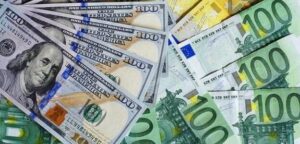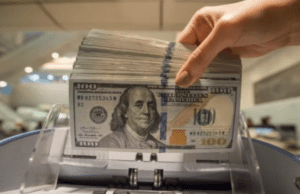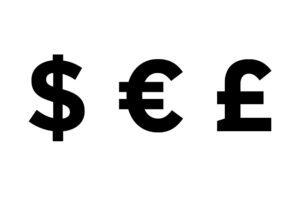
The dollar exchange rate on Thursday morning changes slightly against the euro and the pound, while the US currency is sharply declining against the yen.
The euro/dollar pair is trading at $1.0076 by 8:57 sq.m. against $1.0086 at the close of the session on Wednesday, the euro is losing about 0.1%.
The pound is trading at $1.1625 compared to $1.1628 at the close of the previous session.
The dollar fell 0.8% against the yen to 145.27 yen compared to 146.39 yen the day before. Earlier this month, the yen fell to its lowest level since 1990.
The ICE-calculated index, which shows the performance of the US dollar against six currencies (the euro, the Swiss franc, the yen, the Canadian dollar, the pound sterling and the Swedish krona), is down about 0.1%. Over the past two sessions, the indicator fell by 2% and dropped to a month low.
The main reason for the fall of the dollar this week was the expectation that the Federal Reserve may slow down the pace of raising the key rate as inflation eases and problems in the US economy, writes Trading Economics.
Analysts, on average, expect the Fed to raise rates by 75 basis points in November and expect a 50 bp hike in December.
Also, market participants are waiting for the results of the meetings of the European Central Bank and the Bank of Japan, which will end this week.
The ECB is expected to raise key interest rates again on Thursday by 75 bp. The European Central Bank is constrained from refusing to raise interest rates in the near term as consumer price growth in the euro area is likely to have not peaked yet, BlueBay Asset Management chief investment officer Mark Dowding said in an interview with Dow Jones.
Meanwhile, the Bank of Japan on Friday, most likely, will not change the main parameters of its monetary policy.

The US dollar is steadily strengthening against the euro and the pound sterling, having updated a 32-year high against the yen at the auction on Friday.
Experts no longer rule out that the Federal Reserve System (Fed) will bring the base interest rate to 5%, said Francesco Pesole, an analyst for the foreign exchange market at ING. The two-year US Treasury yield topped 4.6% on Friday.
“The outlook for a Fed rate hike continues to cast doubt on the possibility of a sustained rally in US stocks, and the chances that demand for the dollar as a safe haven asset will rise are quite high,” Dow Jones quoted Pesole as saying.
The ICE-calculated index, which shows the dynamics of the dollar against six currencies (the euro, the Swiss franc, the yen, the Canadian dollar, the pound sterling and the Swedish krona), adds 0.56%, the broader WSJ Dollar Index – 0.65%.
The euro/dollar pair is trading at $0.9748 as of 3:00 pm compared to $0.9788 at the market close on Thursday.
The pound sterling has fallen in price by this time to $1.1113 against $1.1239 the day before.
The pressure on the pound is exerted by both political uncertainty in the UK and signals of the continued deterioration of the situation in the country’s economy.
On the eve of Liz Truss announced her resignation as leader of the Conservative Party, which entails her resignation from the post of prime minister, where she worked for only 45 days.
Meanwhile, retail sales in the UK in September fell by 1.4% compared to the previous month, while experts on average expected them to decline by 0.5%. Retail sales last month were 1.3% lower than pre-pandemic February 2020.
The dollar against the yen is 151.54 yen against 150.15 yen at the close of the previous session. On Friday, Japanese Finance Minister Shun’ichi Suzuki again expressed concern about the sharp weakening of the yen and expressed his readiness to intervene to support the national currency.
On Friday, the Bank of Japan continued unscheduled purchases of government bonds for the second day in a row to contain the growth in the yield of ten-year bonds, which rose above the upper limit of the CBR’s target range of 0.25% per annum.
The dollar/yuan pair is trading at 7.2463 yuan/$1, compared to 7.2164 yuan/$1 at the close of the previous session. The yuan is trading near a 14-year low against the US currency during the 20th Congress of the Communist Party of China, which will end on Saturday.

The value of the US currency against the yen jumped to a maximum since August 1990 after the Japanese Central Bank announced an unscheduled redemption of government bonds. This decision was made following the jump in the yield of 10-year Japanese government bonds above the upper limit of the Central Bank’s target range of 0.25% per annum.
The dollar against the yen soared to 149.98 yen compared to 149.9 yen at the close of the previous session.
The Bank of Japan maintains an ultra-loose monetary policy, thus seeking to support the country’s economic recovery from the effects of the COVID-19 pandemic. His policy is seriously at odds with the actions of other world central banks, raising rates to curb inflation, notes Trading Economics. This continues to put pressure on the yen and requires the Japanese Central Bank to adjust the policy of controlling the yield curve of government bonds.
The ICE-calculated index, which shows the dynamics of the dollar against six currencies (the euro, the Swiss franc, the yen, the Canadian dollar, the pound sterling and the Swedish krona), lost 0.14% on Thursday, the broader WSJ Dollar Index lost 0.05%.
The euro/dollar pair is trading at $0.9792 as of 9:15 Moscow time, compared to $0.9775 at the close of the market on Wednesday.
The pound sterling fell by this time to $1.1221 against $1.1218 the day before.
The dollar remains strong and any downward adjustments will be short-lived as long as the Federal Reserve (Fed) continues to raise the base rate, said ING analyst Francesco Pesole, quoted by Dow Jones.
The Fed’s Beige Book regional survey published on Wednesday showed that forecasts for the US economy have become more pessimistic amid growing concerns about weakening demand.
Economic activity in the country at the beginning of autumn generally slightly increased, but the situation was different in different industries and regions. Four of the twelve Federal Reserve Banks (FRB) said that activity in their districts did not change, and two reported a decrease. Negative factors were higher interest rates and inflation, as well as disruptions in supply chains.

The US dollar is getting cheaper against the euro and the pound sterling at the auctions on Monday, it is stable against the yen.
The ICE-calculated index, which shows the dynamics of the dollar against six currencies (the euro, the Swiss franc, the yen, the Canadian dollar, the pound sterling and the Swedish krona), is losing 0.29%, the broader WSJ Dollar Index – 0.27%.
The euro/dollar is trading at $0.9750 compared to $0.9722 at the market close on Friday.
The rate of the American currency against the yen is 148.72 yen against 148.75 yen following the results of the previous session.
The pound rose to $1.1272 from $1.1183. On Friday, British Prime Minister Liz Truss fired Chancellor of the Exchequer Quasi Kwarteng, appointing Jeremy Hunt to the post.
According to the Financial Times, several British Conservative MPs and prominent figures from the City of London are calling for Truss herself to step down as prime minister after controversial economic decisions that undermined her credibility.
Britain’s new finance minister told the BBC last Sunday, speaking of the possibility of winding down any of the government’s recent stimulus measures, that “nothing is out of the question.”
Later on Monday, Hunt intends to make a statement regarding the country’s medium-term budget.
The dollar rose against the yuan during trading to 7.1996 yuan from 7.1910 yuan at market close on Friday. Chinese President Xi Jinping, speaking at the 20th Congress of the Chinese Communist Party (CCP), which opened on Sunday, signaled that the country’s authorities would continue their tough policy to contain the spread of COVID-19, which has already seriously weakened the country’s economy this year.

US dollar is stable against the euro, strengthening against the yen and the pound sterling on Friday.
The ICE-calculated index, which shows the dynamics of the dollar against six currencies (the euro, the Swiss franc, the yen, the Canadian dollar, the pound sterling and the Swedish krona), adds 0.03% during trading, the broader WSJ Dollar Index loses 0.02%.
The data of the US Department of Labor published the day before showed a weaker-than-expected slowdown in inflation. The CPI rose in September by 8.2% against the same month last year – the lowest rate in seven months. Experts polled by Trading Economics predicted, on average, a slowdown in inflation to 8.1% from 8.3% in August.
Meanwhile, core inflation, excluding the cost of food and energy (Core CPI) accelerated in September to the highest since August 1982 6.6% in annual terms from 6.3% a month earlier.
Published statistical data have strengthened investors in the opinion that the Federal Reserve System (Fed) will continue the rapid tightening of monetary policy. Now traders are waiting for a sharp rise in the rate of the US Central Bank at each of the two remaining meetings of this year, Bloomberg notes.
The euro/dollar pair is trading at $0.9781 compared to $0.9780 at the close of the previous session.
The US currency against the yen is 147.45 yen against 147.22 yen at the close of the market on Thursday.
The pound fell to $1.1322 from $1.1331 the day before.
British Treasury Secretary Kwazi Kwarteng left Washington, where he was meeting with representatives of the International Monetary Fund (IMF), a day earlier than planned. Experts believe that he may abandon part of the tax cuts he announced earlier in order to prevent an economic crisis in the country, the Financial Times writes.
The newspaper’s sources note that the IMF and finance ministers of several other countries recommended that he quickly abandon plans for tax cuts in order to avoid financial problems in the economy.

The dollar is moderately declining against the euro, but growing against the Japanese yen, renewing its maximum value in 24 years.
The ICE-calculated index, which shows the performance of the US dollar against six currencies (the euro, Swiss franc, yen, Canadian dollar, pound sterling and the Swedish krona), is practically unchanged on Wednesday morning, as is the broader WSJ Dollar.
The euro/dollar pair is trading at $0.9721 by 8:52 p.m. compared to $0.9707 at the close of the session on Tuesday, the euro adds about 0.1%.
Meanwhile, the rate of the American currency against the yen rose by almost 0.3% and amounted to 146.25 yen compared to 145.86 yen the day before. This is the highest rate since August 1998. The last time the yen fell to a 24-year low at the end of September, after which the Japanese Ministry of Finance intervened in the foreign exchange market to support the national currency.
The dollar is strengthening against the yen due to mixed monetary policy rates: while the Fed is actively raising interest rates, the Bank of Japan continues to adhere to extremely soft monetary policy.
The pound rose 0.4% to $1.1012 compared to $1.0968 at the close of the previous session.
Traders are evaluating conflicting signals about the Bank of England’s emergency government bond purchase program.
British Central Bank Chairman Andrew Bailey said that the regulator will complete the purchase of bonds on Friday, as planned. “The essence of interventions to stabilize financial markets is partly that this is a temporary phenomenon,” he said.
However, the Financial Times then wrote, citing three anonymous sources, that the Central Bank privately hinted to representatives of some banks about the possibility of extending the bond purchase program in order to protect UK pension funds from losses.